Dress Shirt and Slacks Combinations Black Dress Shirt
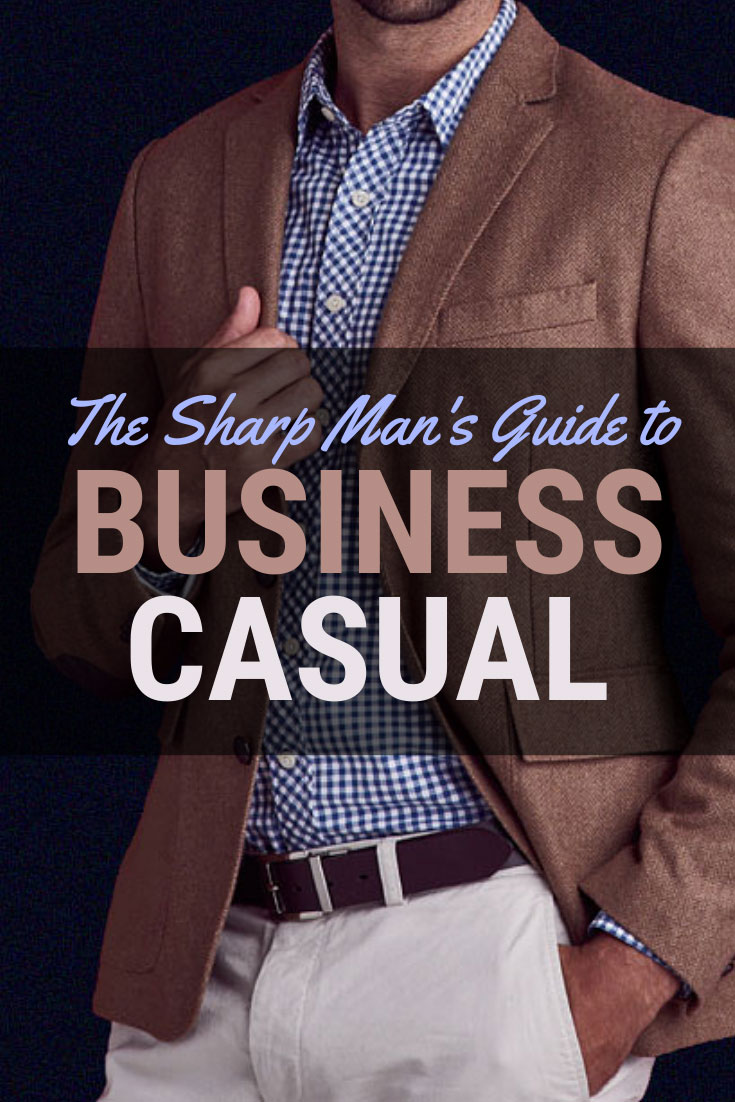
How should business casual men dress?
If you look online, everybody seems to have a different opinion on what is and isn't appropriate for the business casual dress code. And if you read the wrong article, you'll risk underdressing for the occasion.
When an office or event sets a dress code, they expect you to dress up to a certain standard. But defining that standard is hard, because it differs from office to office.
In this article, you'll discover the best ways to dress business casual so that you'll never show up underdressed. We'll go through the rules and essential clothes, give you outfit examples and answer all questions you may have.
What Is Business Casual Attire for a Man?
Business casual is dressing down from a business professional outfits; NOT dressing up a casual outfit. In other words, business casual is dressing down from a suit and tie. The idea behind business casual is to project a professional image while enjoying more casual attire. You must appear neat and groomed, and yet, relaxed at the same time. But never too relaxed.
Appropriate business casual attire includes the following clothes:
- Dress shirt
- Blazer or sports jacket
- Suit
- Dress pants
- Chinos
- Sweater or cardigan
- Accessories such as a tie, pocket square and a watch
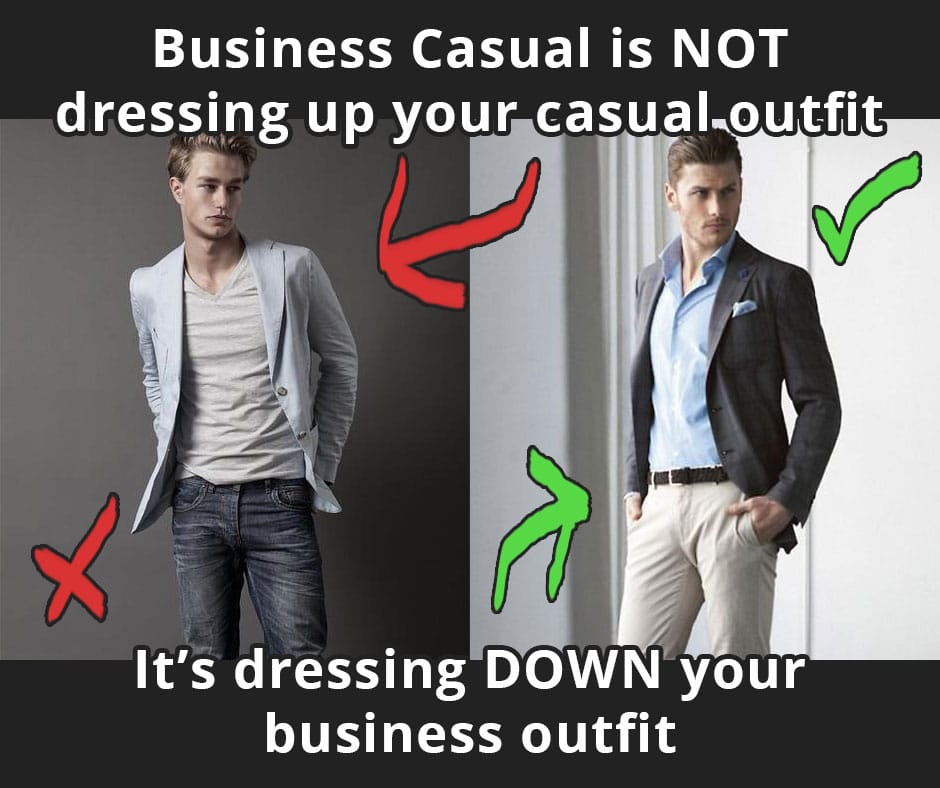
Business casual is not meant to be a casual look. It's a look meant for business purposes. You can't just wear the same casual wear that you wear to your neighbor's barbecue or your favorite bar, such as flip flops or baggy casual pants, no matter how you dress them up.
That's the main principle you should follow. But I know that's not enough to clear up all the confusion. Below, we'll dive into more detail. Here's an overview of all the topics we'll cover:
- Basic Guidelines for the Business Casual Dress Code
- Essential Rules When Wearing Business Casual Attire
- Business Casual Do's and Don'ts
- Are Jeans Business Casual for a Man?
- Why Is Being Overdressed Better?
- Building the Wardrobe: The Essential Business Casual Clothes for Men
- Dress Shirts
- Pants
- Shoes
- Suits
- Jackets
- Sweaters/Cardigans
- Accessories
- 4 Business Casual Examples of Men's Outfits
- A Fun History of Business Casual Clothing!
- FAQ about Business Casual Attire for Men
- What is the difference between business casual and business professional?
- What should I wear on the first day of business casual?
- What is the best business casual interview outfit for men?
- What is business casual for men in summer?
- How do you dress business casual in the winter?
- Are polo shirts business casual?
- Do you have to tuck in your shirt for business casual?
- Are boots business casual for men?
- Are khaki pants business casual?
- Are black jeans business casual?
- Can you wear sneakers in business casual?
Your Basic Guidelines for the Business Casual Dress Code
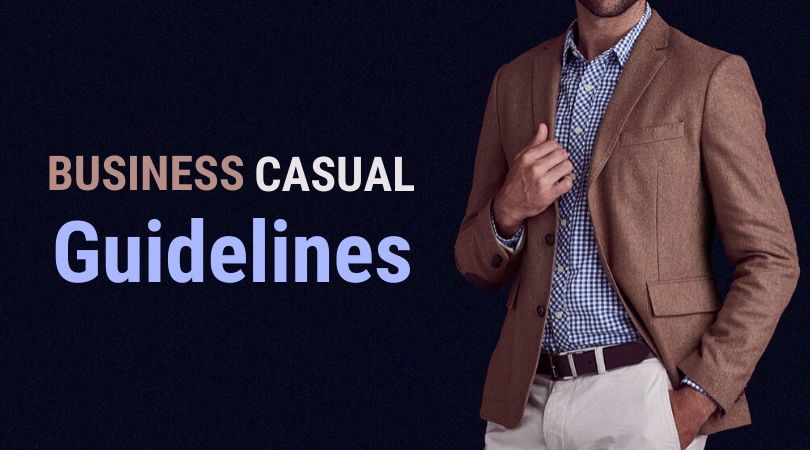
So business casual men should dress down from a suit, but what exactly does that mean?
What is considered business casual attire in men's fashion?
Well, your business casual wardrobe should always include a suit or sports coat, a dress shirt, slacks or chinos, an optional tie, and dress shoes.
Now, let's go over some rules.
3 Essential Rules When Wearing Business Casual Attire
These are just the basics:
- Your business casual wear should always be clean, unwrinkled and have at least some formal elements. You should, at the very least, wear a collar.
- Your clothes should always fit you properly. This is something the well-dressed man should always ensure, even when dressing casual, but it becomes even more important when dressing for business purposes. After all, you don't want to make a sloppy impression on a potential client or employer. It could hurt your career.
- If you are just starting to build a business casual wardrobe, stick to neutral colors such as white, black, grey, tan, navy, and brown for your business casual shirts and pants. This way, your business casual wear will never go out of fashion and will be easy to mix and match.
Business Casual Do's and Don'ts
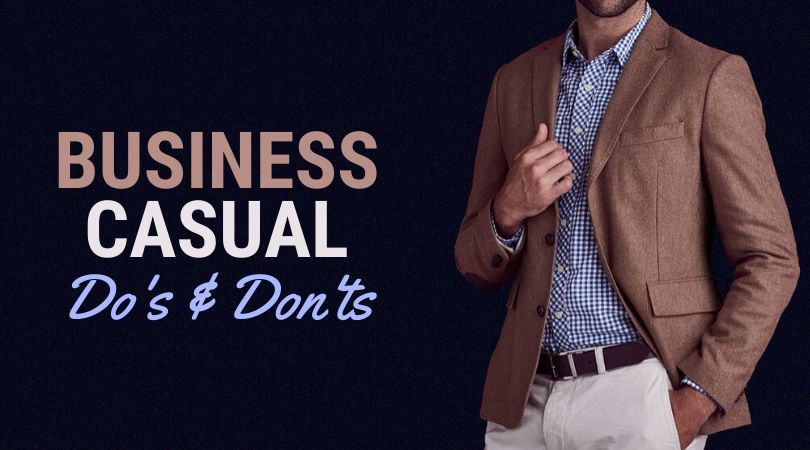
If you want a simple overview of what you should or shouldn't wear for a business casual look, these are some quick do's and don'ts:
- Do wear dress shirts, sweaters, cardigans, and/or tailored jackets.
- Don't wear sneakers, jeans or t-shirts.
- Do wear a tailored jacket with a tie.
- Don't wear a tie with a suit. (You can, but it's not business casual.)
- Do wear dress pants or chinos.
- Don't wear shorts, sandals or slippers.
- Do wear dress shoes, watches and pocket squares.
- Don't wear loud patterns or colors.
- Do wear clothes that fit properly.
- Don't dress up your casual outfit.
- Do dress down your business outfit.
- Do project a professional image, even if you're wearing more casual attire
- Do check the dress standard of the other employees at your company and aim to take it up a notch.
There are also situations in which you definitely should NOT dress business casual:
- Don't dress business casual for important meetings with clients, managers or executives.
- Don't dress business casual when representing your company in the media, at a conference, or at an event.
- Don't dress business casual for important job interviews (unless you're 100% sure they have a casual dress code, in which case, I'd still suggest wearing a suit sans tie).
Are Jeans Business Casual for a Man?
You may not like hearing this — but denim jeans are off-limits when it comes to business casual men's fashion. Even dark denim, black jeans, or dark wash jeans are not suitable.
In some cases, an office might have a business casual dress code and allows jeans, but you'd want to err on the side of safety and not wear them until you know for sure.
And while we're at it, t-shirts and sneakers are off limits too.
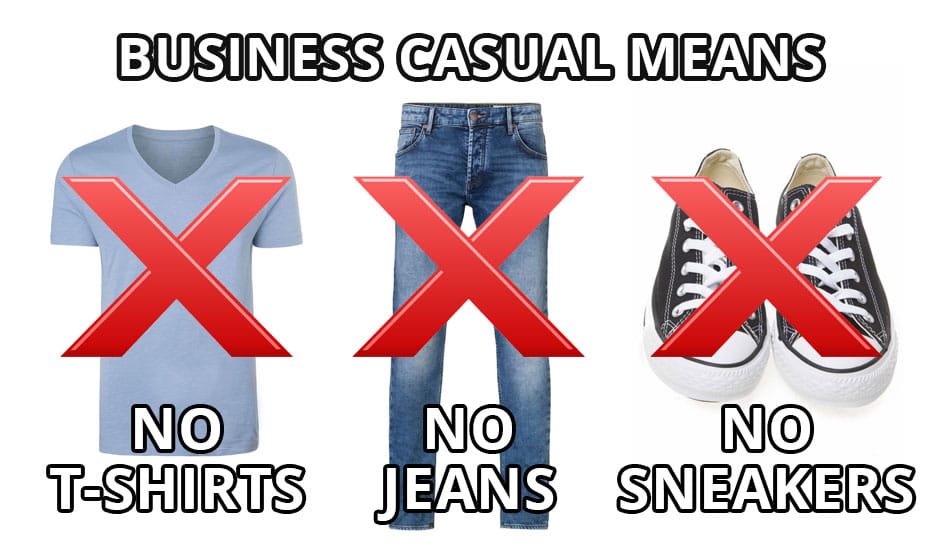
The business casual dress code ranges from suits without ties to wearing just shirts and pants. Dressing down further would take you too far into casual territory.
Yes, you've seen great outfits that combine denim, v-neck t-shirt and white sneakers with sport coats. But those looks are a too casual style for business-casual.
Always lean towards the business side rather than the casual side. Think of it as your business professional attire, but slightly less formal.
Note: Some companies will allow denim jeans, or even T-shirts, so you might get away with it. But ask yourself whether you want to wear clothes that you get away with or wear ones that make the most professional impression at your workplace.
Why Is Being Overdressed Better?
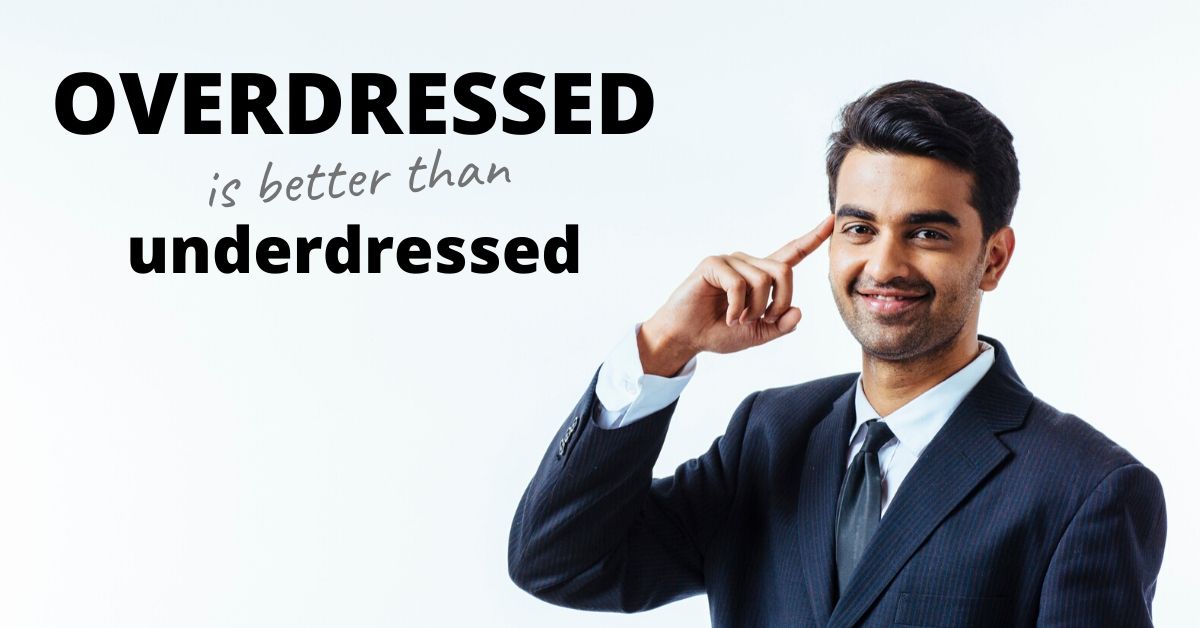
Once you've been to an office, you can just gauge the room and see what everyone else is wearing. (I'd still recommend taking it up one notch).
But if you haven't been there before and you're unsure how they expect you to dress, then remember that overdressed is better than underdressed.
At least when you're overdressed, you still present yourself as a professional. When you're underdressed though, your potential client or boss might just think you don't take your job seriously enough.
And that's the last thing you want, right?
So always keep professionalism in mind, and when in doubt, dress up.
Wear the right clothes and wear them the right way…
Building the Wardrobe: The Essential Business Casual Clothes for Men
So by now you should have a clearer idea of what business casual clothing looks like, and you have some basic guidelines to follow.
So let's dig a little deeper and go through all clothes that belong in a man's business casual wardrobe and how to get the look right.
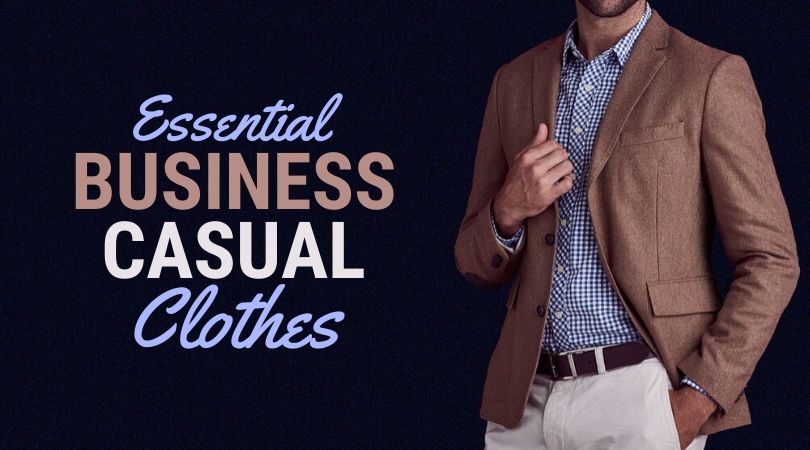
1. Dress Shirts
Dress shirts are the quintessential business casual shirts. Every outfit we'll cover in this article will involve one of these.
You may find offices that will allow a tucked in polo shirt in summer, but for a true business casual look, stick to dress shirts. (You can always go for linen when the temperatures are high. )
Start off your wardrobe with dress shirts in traditional colors like white and light blue. A white button-down oxford is a classic go-to shirt for business casual attire. You might also opt for alternatives like light pink, mint green or lavender.
You might consider subtle patterns like gingham or pinstripes. But avoid business casual shirts that are too bold or trendy in design. Remember that you want to err on the conservative side when selecting your professional attire.
Fit is essential, so try out the three main types of dress shirts: slim fit, regular fit, and relaxed fit to see which goes best with your body type. (You might also check out my article on how dress shirts should fit.)
While current fashion trends seem to prefer a slim fit, select it only if it compliments your body type and you feel comfortable. Whenever in doubt, choose long-sleeved shirts in a regular fit.
What about button-down vs. button-up? What's the difference?
A button-down shirt has buttons that fasten the collar to the body of the shirt. A button-up shirt, on the other hand, has a stiffer collar and may use a plastic shirt stay to keep the collar in place.
Both are fine for business casual attire.
Which reminds me — tuck your shirt in! An untucked shirt has no business being in a business-casual outfit. And unless you're wearing a tie, leave your top two buttons of your shirt undone (unless that shows too much skin or chest-hair; then just leave the top one undone).
Business-Casual Shirts
2. Pants
What type of pants are business casual?
As I mentioned, jeans are a no-go, so on your bottom half, you want to wear either dress pants or chinos. Make sure your pants fit well and don't crease too much around the ankles. Go for a no-break to half-break.
What's the "break"?
The break is the fold or creasing of the fabric where your pant leg meets your shoe.
There's a thin difference between a no-break well-fitting pair of pants and pants that are too short. So ensure you have a good tailor at hand to alter your dress pants.
And again, start with more conservative colors like navy, grey or camel. If you do wear more colored pants, make sure they're appropriately muted.
Business Casual Pants
Business Casual Chinos
3. Shoes
When you're dressing business casual, the only footwear you want to look at is sneakers.
I kid, of course. Sneakers have as little business being in a business-casual outfit as tennis shoes or flip-flops.
As I explain in my post on business casual shoes for men, you can choose from the following seven options:
- Oxfords
- Derbies
- Brogues
- Monk Straps
- Chelsea Boots
- Dress Boots
- Loafers (in suede or leather)
Get a pair of dress shoes in black and brown, so you have a couple of appropriate lace-up shoes to wear with any color of your pants.
Chukka boots tend to bend more towards the casual, so avoid them in a business casual outfit.
Keep socks in neutral colors of brown, black, grey, or beige. Or, if you want to play matchy, find socks with subtle patterns that include both the color of your pants and shoes.
Business-Casual Dress Shoes
4. Suits
Some business-casual offices still expect you to wear a suit to work. They just allow you to leave the tie at home.
But even when you don't have to wear a suit to work, doesn't mean you never should. It still looks most professional (and handsome as well, so the ladies tell me).
Having a suit (or a few) in your wardrobe will also come in handy when you need to step your personal presentation up a notch. What if you're meeting an important client or have to give a presentation for upper management?
Wearing a suit gives you the most professional image, even if you forego the tie.
Business-Casual Suits
5. Jackets
While some business casual offices still expect you to wear a suit, others are fine as long as you wear a jacket.
If that's your situation, navy or grey blazers, tweed sports coats, corduroy jackets and quilted jacket are your basic go-to's.
A dark blazer worn over a long-sleeved shirt with a tie and leather shoes is classic business casual attire that always looks smart.
Business-Casual Jackets
6. Sweaters/Cardigans
Sweaters and cardigans also make fine layering pieces for a business-casual outfit.
In some offices, you may only wear them during winter, as a middle layer between your shirt and jacket. But other offices allow you to wear them as a substitute for your jacket.
But don't think you can just wear that chunky Christmas sweater your grandma knit for you. A v-neck sweater in merino wool works very well as a substitute for a jacket.
Keep your v-neck sweater or cardigan lightweight and solid. Leave the chunky knits and bold patterns for more casual occasions.
You can be a bit bolder when it comes to color though, so don't be afraid to lighten your office up with a pop of red or yellow. But if you do wear bright colors, pair it with a neutral-colored shirt like a white button-down.
Business-Casual Sweaters & Cardigans
7. Business Casual Accessories
Accessories are essential in any men's fashion wardrobe when you want to take your fashion quotient up a notch.
Let's go over a few business casual accessories.
Ties
You don't always need to wear a tie when you dress business-casual. In fact, the business-casual craze started with just leaving the tie at home.
But especially when your outfit leans more casual — say, when you're wearing a cardigan and chinos instead of a suit — a knit tie can slide your outfit back a bit more toward the business side.
Of course, you don't dress business casual to black tie events, so you can play around with patterns and colors, or even opt for a knitted tie.
Bags
When it comes to sporting a business casual look, a backpack has no place. You want to go for something classier.
Instead, opt for a leather bag or canvas-leather bag in brown or black. An all-canvas bag or a portfolio may also work for you but stick to neutral colors and classic, clean, functional designs.
Belts & Watches
Most people don't consider belts and watches as necessary accessories. But a smart, stylish man would.
The classiest business casual style for the belt would be plain or braided leather in brown or black. When it comes to watches, nothing beats a brown leather strap style.
You want to make sure your leather belt and watch match your leather shoes.
What this means is – if you are wearing brown leather shoes, your leather belt should also be brown as should be the leather strap of your watch.
Pocket Squares
Pocket squares can bring a dash of color to your business casual attire. If you are wearing a blazer or a jacket, team it with a contrasting pocket square. When worn with a tie, try and have your pocket square complement rather than match the tie. One easy way to do so is by having one color in the pocket square pattern match the tie (or vice versa).
4 Business Casual Examples of Men's Outfits
Now that you know what clothes are essential for dressing business casual, let's cover a few examples of business casual outfits you could put together.
Different professions have different standards of what is the appropriate business casual look. As a banker or lawyer, you likely need to be dressed more formally as opposed to if you work at a startup.
(When starting a new job, it is better to be overdressed for the first day in office. You can also discuss with the HR or a colleague to understand what business casual means at your new office.)
I've ranked these men's business casual examples from most formal to least formal, and as I've said before, which one's most suitable depends on your office. But if you're unsure, start with the top one, and dress yourself down from there.
Better to be overdressed on the first meeting than underdressed, remember?
1. The Suit Sans Tie
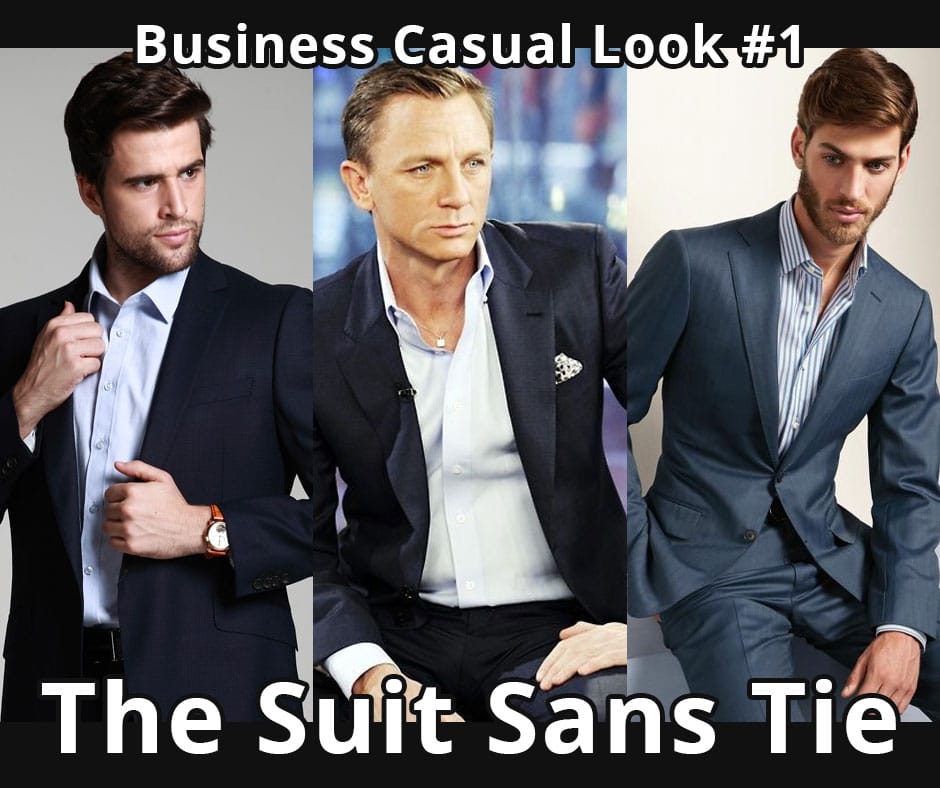
Is a suit without a tie business casual?
Yes, it's the most formal of business casual outfits and is a great choice for when you're not sure how casual the office or event expects you to be. It's a safe choice.
The suit without tie, worn with a button-down shirt, this look is just one step down from business-formal and still looks the most professional.
Also make sure to wear a nice watch that's not too blingy. A leather strap with a subtle silver or gold face is fine. Avoid silver or gold straps.
And consider sprucing the outfit up a bit with a pocket square. You're going without a tie, which frees up the neck, but also diminishes the visual interest some. Adding a pocket square will fix that.
This outfit is actually quite safe when it comes to dressing business casual. When you arrive at an office that's one rung down on the dressy ladder (i.e. look #2), you wouldn't stick out too much in a suit sans tie. And if you arrive at an office where the dress code is more casual (i.e. look #4), you can just take off your jacket to fit right in.
Simple, right?
2. The Odd Jacket
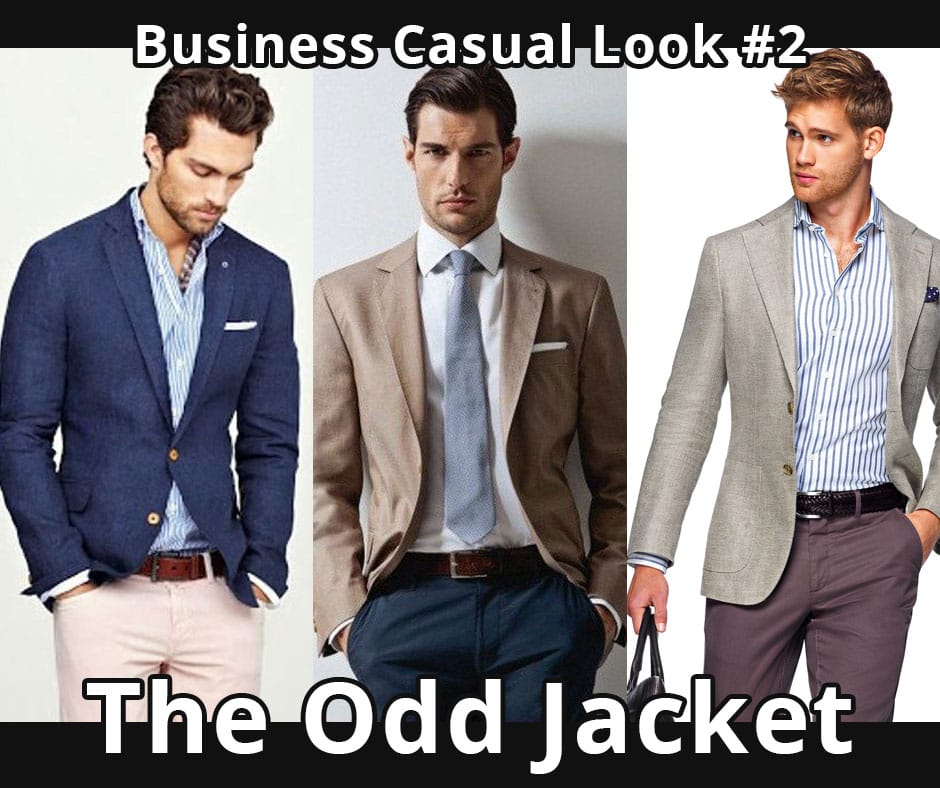
The term odd jacket isn't used much anymore, but it means a jacket that wasn't made with a matching pair of pants. Whenever you wear a jacket with pants that don't match the color and fabric of the jacket, you're wearing an odd jacket.
So that means your navy blazer, tweed spots coat or corduroy jacket.
You can pull this look off in two ways: With dress pants or with chinos. The dress pants will give you a dressier look whereas the chinos are a tad more casual.
Both looks will probably be fine if your office has this standard of business-casual, but the dress pants will give you a more professional edge.
3. The Dressed-Up Knit
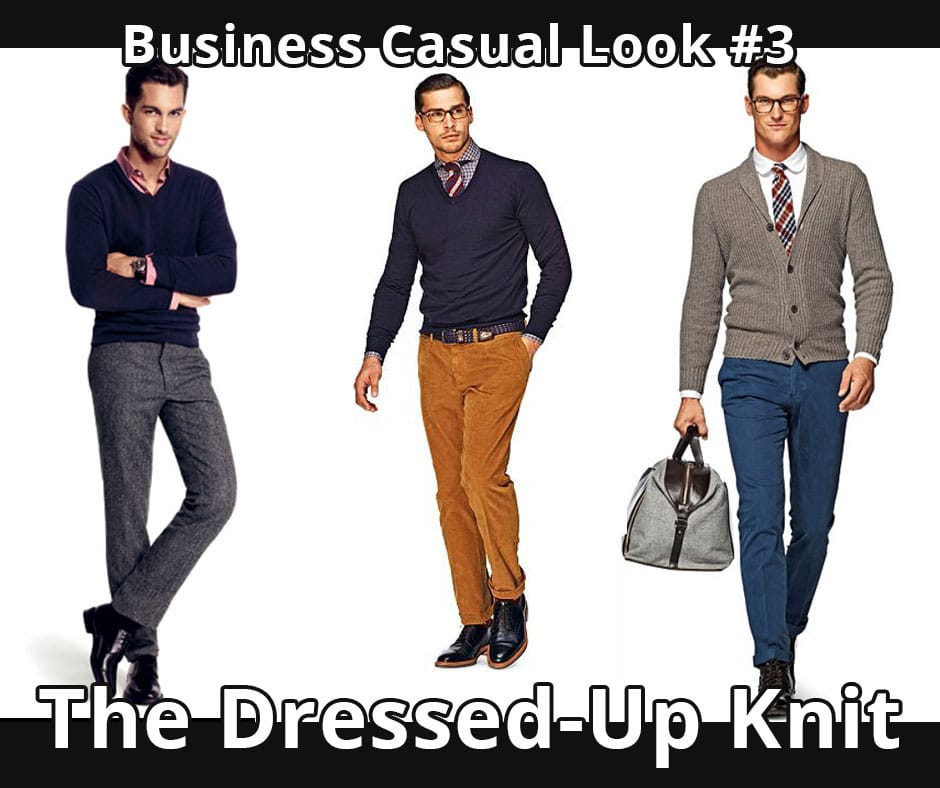
The dressed-up knit outfit has you wearing a sweater or cardigan over your business casual shirts instead of a jacket.
This look leans far more towards casual than the previous two, so I'd recommend pairing the knitwear with dress pants, rather than chinos. The latter works too, but dress pants will slide the look back towards business a bit.
And as I mentioned earlier, pairing a tie with your knitwear will have the same effect.
4. The Shirt & Slacks
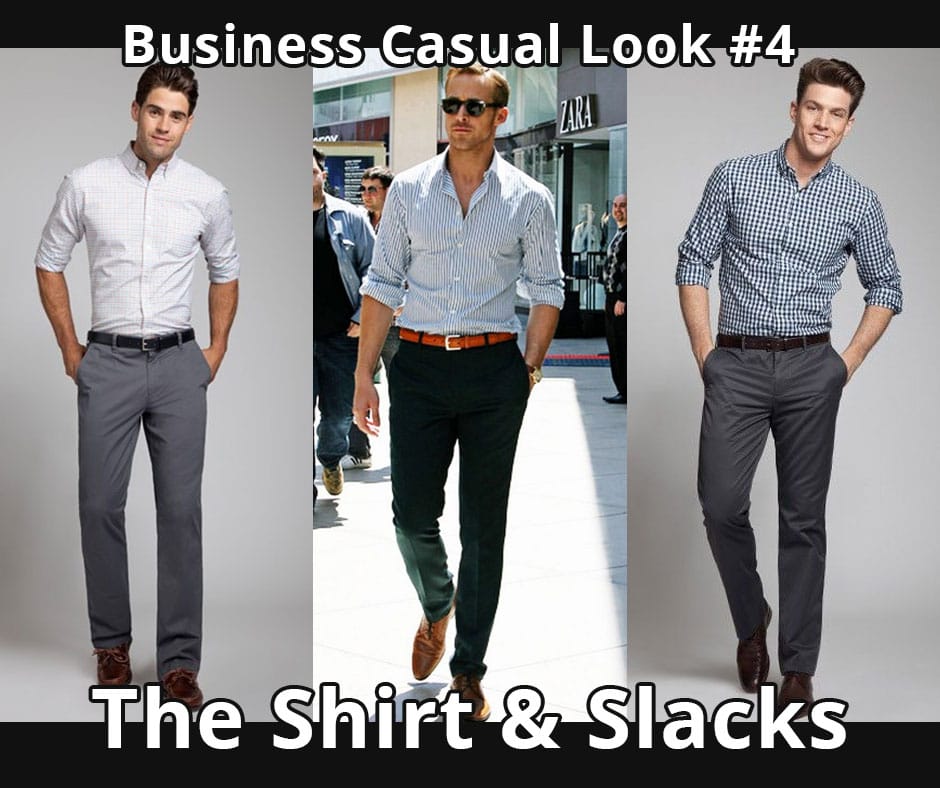
This is the most casual of the business-casual looks. It leaves both the jacket and tie at home.
Like with the previous look, go with dress pants rather than chinos to avoid venturing too far into the casual wardrobe territory.
However, unlike the previous look, don't try to elevate this by adding a tie. Wearing a tie without a jacket makes you look boyish. It's the outfit your mom made your younger self reluctantly wear to a wedding.
And that's exactly the impression you'll make, except now your boss makes you wear the tie and you refuse to go all the way with a jacket. Not a professional look, my friend.
So either wear a jacket and tie or wear neither. You can take the jacket off as you sit down to work, or even carry it on your arm as you move from your office to a client's. Just having it around will make the tie look deliberate.
A Fun History of Business Casual Clothing!
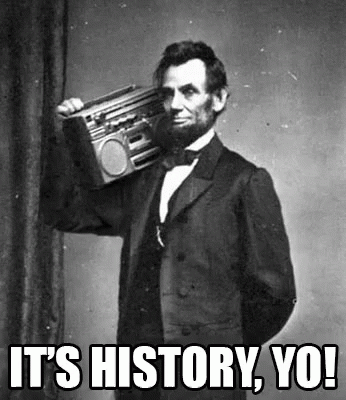
Ever wondered where this concept of business casual came from?
It all started with Aloha Friday!
Till the mid-60s, businesses had a very strict professional dress code for men's clothing. Men had to wear a formal suit with a shirt and tie.
Period.
Then in 1966, the Hawaiian shirt industry came up with a brilliant marketing plan to increase shirt sales. They encouraged local businesses to allow their employees to wear their most colorful Hawaiian casual shirt once a week.
They called it Aloha Friday.
The message was not to take yourself too seriously and not to get caught up too much in the rat race. have a little fun in life.
Aloha Friday: Don't Take Yourself Too Seriously
"Aloha Friday" was hugely popular and soon after drifted to the mainland, becoming known as Casual Friday. Before long, the rest of corporate America was wearing clothing like slacks, t-shirts, and dark denim to their workplace every day.
But, then people took it too far, started wearing shorts and flip flops to work. People in upper management started to feel people were having a bit too much fun with Casual Fridays.

The time was ripe for another shift in the formal dress code trend, and it happened with a little nudge from Levi Strauss & Co.
In the early '90s, Levi's launched a series of marketing campaigns to boost sales of Dockers — its new brand — to the corporate world. They printed a brochure called "A Guide to Casual Businesswear," that showed different business casual looks and sent it to HR departments across the country.
The business casual men's style prominently featured Dockers paired with a button-up shirt and loafers, or with a long-sleeved shirt and jacket.
Their timing worked well. Companies struggling to keep their employees' dress code geared towards the formal, directed their employees to refer to Levi's brochure when dressing up in professional attire.
Other brands, like Ralph Lauren, Jos A. Bank, Brooks Brothers and J.Crew also jumped into the fray with their line of men's style casual office wear.
And the business casual dress code was born.
FAQ about Business Casual Attire for Men
What is the difference between business casual and business professional?
Business professional attire is always composed of a suit and tie. Business casual is the dressed down version of business professional, which means you can keep the suit but lose the tie, wear dress pants with a blazer, or wear a wider variety of more casual clothes, such as chinos, sweaters and cardigans.
What should I wear on the first day of business casual?
On your first day, if you're unsure of how casual or formal the office expects you to be, the safest choice is to wear a suit without tie. Alternatively, wearing a sports coat with a dress shirt and dress pants should also be fine in most cases.
What is the best business casual interview outfit for men?
The safest choice is to wear a grey or navy suit and a dress shirt with a leather belt and leather dress shoes. But if you're unsure, the best thing you can do is call ahead, tell the receptionist you have a job interview, and ask her what the most appropriate office attire is.
What is business casual for men in summer?
Even when the temperature rises, you can still pull off a business casual look by picking light-weight, breathable fabrics. For instance, you can wear a linen or seersucker suit or blazer instead of wool. Instead of dark navy or grey, you can chose lighter colors like light brown, light blue or light grey.
Of course, if you go without a jacket, sticking with just the shirt and slacks is also option. You can wear a linen shirt and choose chino pants in a lighter, more breathable cotton. Some offices may even allow you to wear a short sleeve shirt or polo shirt.
If you want more advice, check out my guide on how to dress in summer.
How do you dress business casual in the winter?
The beauty of winter is that you can put your layers to full effect to keep yourself warm. For example, you can layer an undershirt and dress shirt with a sweater and jacket, and of course a winter coat when you're outside. Of course, You also want to opt for warmer fabrics like wool, especially for your top layers.
If you want more advice, check out my guide on how to dress for winter.
Are polo shirts business casual?
Some offices also allow polo-shirts in summer, but those belong more in a casual wardrobe than as professional attire. Go there only when the heat is otherwise unbearable (and you know your office allows it). And if you do wear a polo, make sure you tuck it in.
Do you have to tuck in your shirt for business casual?
Yes, for a business casual look, you have to tuck in your shirt. An untucked shirt is far too casual for the business casual dress code. You always want to tuck in your shirt to create a more professional, put-together image.
Are boots business casual for men?
Yes, certain men's boots are fine to wear in a business casual outfit. Specifically, you should feel free to wear chelsea boots and dress boots, as well as dressier looking chukka boots.
Are khaki pants business casual?
Yes, khaki pants are a classic choice for business casual. You can wear either khaki dress pants or khaki chinos, and you'll be fine.
Are black jeans business casual?
Black jeans are still jeans, and those are not traditionally considered appropriate for business casual. With that said, some office do accept that you wear jeans, but you'd want to first make sure and show up with chinos or dress pants to be on the safe side.
Can you wear sneakers in business casual?
Sneakers are not appropriate for business casual outfits. Just like with jeans though, certain offices will accept them. If your office allows them, make sure you go for a pair of clean classic-looking white sneakers and nothing too extravagant.
Now You Can Join the Business Casual Men Who Get it Right
You know now what business casual means for men, and how to make it work. So don't be the guy that emphasizes the casual when you have to dressbusiness casual. Be the guy that gets it right.
Even if the rest of your office is wearing jeans, just hold yourself to a higher standard. Take it one step up. Be the guy that look professional, even if you're the only one. You'll stand out in the right way.
The people who matter will notice.
Dress Shirt and Slacks Combinations Black Dress Shirt
Source: https://restartyourstyle.com/business-casual-for-men/
0 Response to "Dress Shirt and Slacks Combinations Black Dress Shirt"
Post a Comment